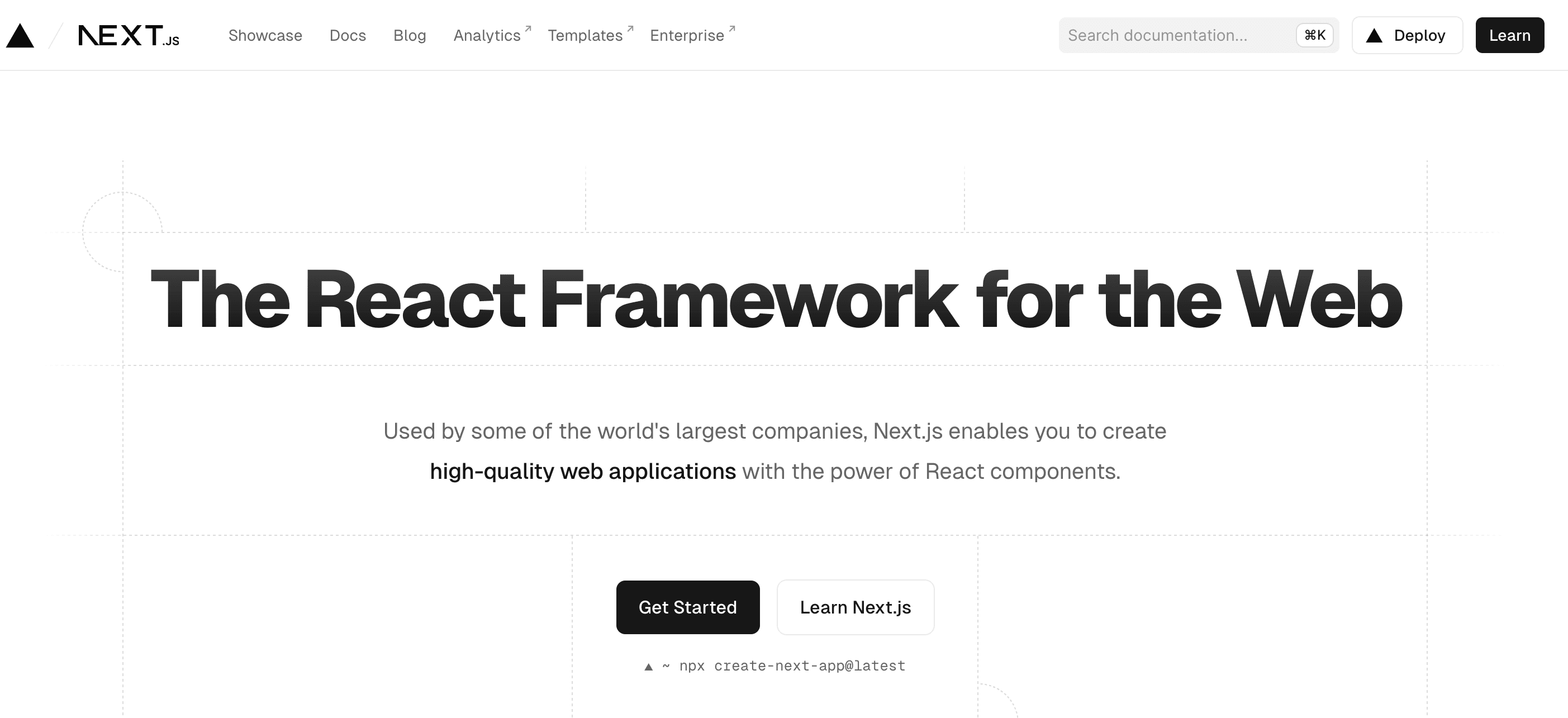Next.js Community Contribution: Where To Start
- User Experience

In the ever-evolving web development landscape, community contribution is pivotal in shaping the future of frameworks and libraries. One such framework that has garnered significant attention and adoption is Next.js. However, the strength of Next.js lies not only in its features but also in the vibrant community that surrounds it.
Join Kapsys as we explore the world of Next.js community contribution, exploring what it entails and where aspiring contributors can begin their journey.
What is Next.js
Before diving into community contribution, it's crucial to grasp the fundamentals of Next.js.
Next.js is a React framework developed by Vercel for building server-rendered web applications. It supports server-side rendering and static site generation, resulting in faster initial page loads and improved SEO.

Here are some of the best Next.js features that you need to know about:
Automatic Code Splitting: Next.js automatically splits code at the page level, resulting in faster load times and improved performance.
Client-side Routing with Prefetching: Next.js provides a streamlined routing system with automatic prefetching for faster navigation.
API Routes: Developers can create API routes alongside pages, simplifying backend functionality.
CSS and Sass Support: Next.js supports CSS modules and integrates seamlessly with Sass for advanced styling options.
Image Optimization: Built-in image optimization ensures fast loading times and a better user experience.
TypeScript Support: Next.js natively supports TypeScript, enhancing code quality and developer productivity.
Internationalization (i18n): Next.js includes built-in support for internationalization, simplifying localization for multiple languages.
Read: Why Choose Next.js for Your Next Web Project?
Why Contribute to the Next.js Community?
Community contribution is at the heart of Next.js's growth and evolution. Here are some of the main benefits of community contribution:
Skill enhancement
Next.js community contribution allows developers to enhance their skills and knowledge by working on real-world projects, collaborating with experienced developers, and learning from their expertise. Whether writing code, improving documentation, or troubleshooting issues, each contribution provides valuable learning experiences.
Networking opportunities
Engaging with the Next.js community opens doors to networking opportunities with like-minded developers, industry experts, and potential collaborators. Participating in forums, discussion groups, and events allows developers to connect with peers, exchange ideas, and establish valuable connections that can lead to future collaborations or career opportunities.
Contribution to open source
Next.js community contribution is a meaningful way to give back to the open-source community and contribute to the collective advancement of technology. By sharing knowledge, code, and resources, developers play a vital role in improving the framework, addressing issues, and making Next.js more accessible and robust for everyone.
Keeping abreast of trends
Active Next.js community contribution informs developers about the latest trends, updates, and best practices in web development. By visiting connected with the community and following discussions, developers can stay ahead of the curve and adapt to new technologies and methodologies as they emerge.
Read: Strapi Forums: A Beginner's Guide To Contribution

Types of Community Contribution in Next.js
Now, as we explored why community contributions are essential, let's take a look at contributions that are highly sought after in the Next.js community:
Code contributions
Code community contribution is one of the most direct ways to contribute to Next.js. The Next.js repository on GitHub is the central development hub, where contributors can submit pull requests to propose changes, fixes, or new features. Whether fixing a bug, optimizing performance, or adding new functionality, code contributions are crucial in advancing Next.js.
Here's how to get started with code community contribution:
Familiarize yourself with the codebase
Start community contribution by exploring the Next.js source code and familiarizing yourself with its architecture, design patterns, and coding conventions. Pay attention to areas that interest you or align with your expertise.
Browse open issues and feature request
Next.js maintains a list of open issues and feature requests on GitHub, a starting point for potential contributions. Look for issues labeled as "good first issue" or "help wanted" to find tasks suitable for beginners.
Contribute bug fixes and features
Once you've identified an issue or feature to work on, fork the Next.js repository, create a new branch for your changes, and start coding. Follow the project's community contribution guidelines and submit pull requests with your proposed changes.
Review and test pull requests
You can help review and test pull requests other community members submit. Providing constructive feedback and testing changes in different environments helps ensure the quality and stability of the Next.js framework.
Read: Improving Performance: Next.js Application Optimization
Documentation enhancements
In addition to code contributions, improving the Next.js documentation is another valuable way to contribute to the community.
Documentation enhancements can include clarifying existing documentation, adding new guides or tutorials, updating examples, and translating documentation into different languages. By enhancing the documentation, contributors help make Next.js more accessible and user-friendly for developers worldwide.
Here's how to contribute to documentation:
Identify areas for improvement
Start community contribution by exploring the existing documentation and identifying areas that could be clarified, expanded, or updated. Look for common pain points developers might encounter or topics that must be adequately covered.
Submit documentation pull requests
Next.js is hosted on GitHub, making it easy for anyone to contribute. You can fork the Next.js repository, make changes to the documentation, and submit pull requests with your improvements. Follow the community contribution guidelines outlined in the repository to ensure your changes are properly reviewed and merged.
Provide examples and tutorials
Developers often find examples and tutorials helpful in understanding how to use specific features or solve common problems with Next.js. Consider adding code snippets, demos, or step-by-step tutorials to enhance the documentation and make it more accessible to a broader audience.
Read: How Companies Can Leveraging Next.js
Bug reporting and issue triage
Identifying and reporting bugs is another vital aspect of community contribution in Next.js. Here's how you can help:
Identify and report bugs
Report issues or unexpected behavior while using Next.js by opening GitHub issues in the Next.js repository. Providing detailed descriptions, steps to reproduce, and code examples help maintainers diagnose and address the issues promptly.
Assist with issue triage
You can contribute to the bug-fixing process by verifying reported issues, attempting to reproduce them in different environments, and providing additional context or insights. This helps streamline the bug-fixing process and allows maintainers to prioritize issues based on severity and user impact.
Read: The Difference Between React And Nextjs: How They Compare?
Supporting the Next.js ecosystem
Beyond documentation and core contributions, there are numerous other ways to contribute to Next.js' community.
Sharing knowledge and expertise
Write blog posts, articles, or tutorials about Next.js, sharing your experiences, tips, and best practices with the community.
Participate in online forums, discussion groups, and social media channels related to Next.js, answering questions and helping fellow developers troubleshoot issues.
Creating and maintaining plugins and extensions
Develop plugins, extensions, or integrations that enhance the functionality of Next.js or integrate it with other tools and services.
Maintain existing plugins or libraries, ensuring they remain compatible with the latest versions of Next.js and addressing any reported issues or bugs.
Organizing events and meetups
Host local or virtual meetups, workshops, or conferences focused on Next.js, providing opportunities for developers to network, learn, and collaborate.
Contribute to community-driven initiatives such as hackathons, code sprints, or open-source projects that leverage Next.js.
Additional Best Practises for Next.js Community Contribution
In addition to commonly discussed best practices for Next.js community contribution, such as code contributions and documentation enhancements, several less talked-about practices can greatly benefit both contributors and the community as a whole:
Accessibility and Inclusivity: Prioritize accessibility standards and translate documentation to ensure Next.js is accessible to all developers.
Translation and Localization: Contribute to translating resources into multiple languages, making Next.js more accessible globally.
User Experience (UX) Feedback: Provide feedback on the usability of Next.js documentation and tools to improve the user experience.
User Story Contributions: Instead of focusing solely on technical contributions, share user stories and real-world use cases of Next.js.
Community Surveys and Feedback Loops: Initiate community surveys or feedback loops to gather insights and preferences from Next.js users. This data can guide feature prioritization and development efforts, ensuring that Next.js meets the evolving needs of its community.
By taking these steps, you can embark on a fulfilling journey of community contribution in Next.js, positively impacting the framework and the developers who rely on it.
Read: How To Build A Simple Blog With Next.js Markdown

Conclusion
Community contribution is the lifeblood of Next.js, driving innovation, collaboration, and growth within the ecosystem. Whether through code contributions, documentation enhancements, bug reporting, or community engagement, developers have myriad opportunities to make a meaningful impact on Next.js and its community.
By actively participating in the Next.js community, developers hone their skills and contribute to the collective advancement of web development. As Next.js continues to evolve, community contributions will remain instrumental in shaping its future and empowering developers worldwide.
Keep up with Kapsys and learn about Next.js and much more!


